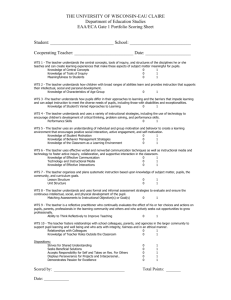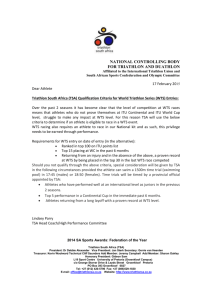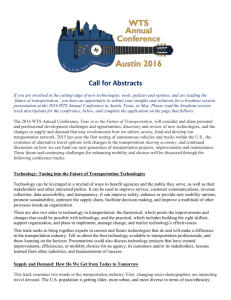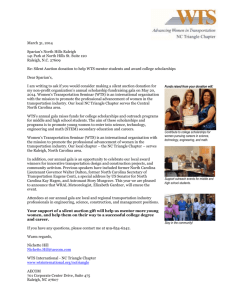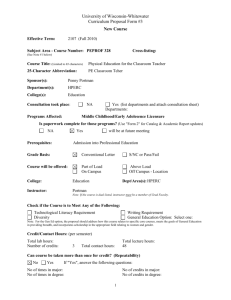Proceedings of the 2014 Industrial and Systems Engineering Research Conference
advertisement
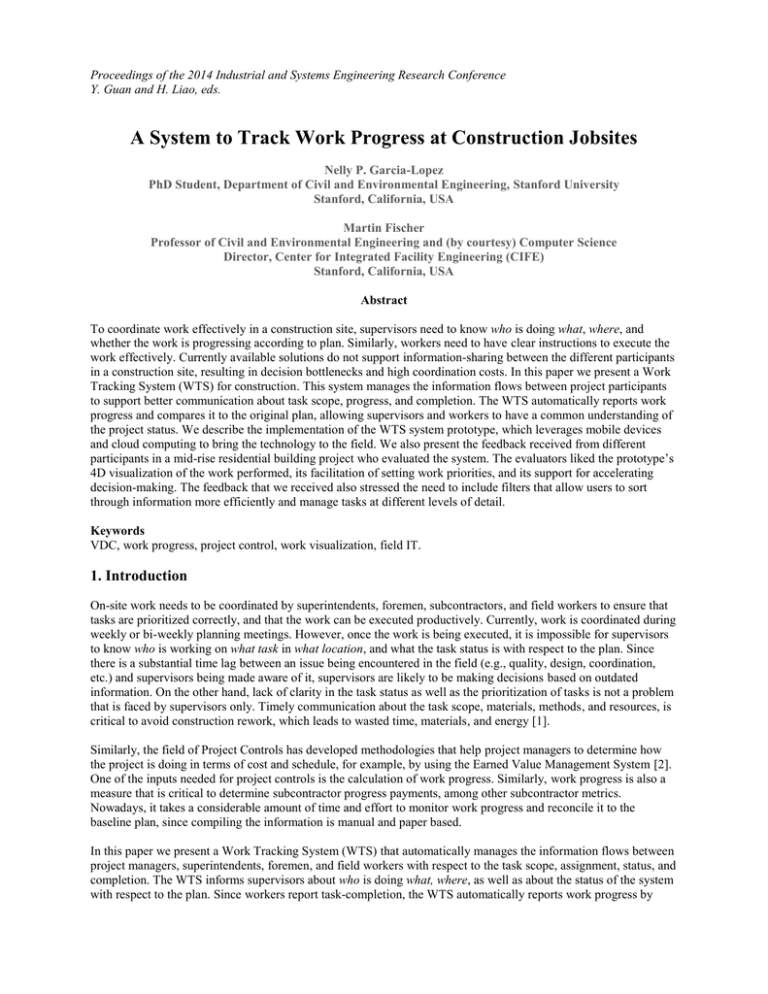
Proceedings of the 2014 Industrial and Systems Engineering Research Conference Y. Guan and H. Liao, eds. A System to Track Work Progress at Construction Jobsites Nelly P. Garcia-Lopez PhD Student, Department of Civil and Environmental Engineering, Stanford University Stanford, California, USA Martin Fischer Professor of Civil and Environmental Engineering and (by courtesy) Computer Science Director, Center for Integrated Facility Engineering (CIFE) Stanford, California, USA Abstract To coordinate work effectively in a construction site, supervisors need to know who is doing what, where, and whether the work is progressing according to plan. Similarly, workers need to have clear instructions to execute the work effectively. Currently available solutions do not support information-sharing between the different participants in a construction site, resulting in decision bottlenecks and high coordination costs. In this paper we present a Work Tracking System (WTS) for construction. This system manages the information flows between project participants to support better communication about task scope, progress, and completion. The WTS automatically reports work progress and compares it to the original plan, allowing supervisors and workers to have a common understanding of the project status. We describe the implementation of the WTS system prototype, which leverages mobile devices and cloud computing to bring the technology to the field. We also present the feedback received from different participants in a mid-rise residential building project who evaluated the system. The evaluators liked the prototype’s 4D visualization of the work performed, its facilitation of setting work priorities, and its support for accelerating decision-making. The feedback that we received also stressed the need to include filters that allow users to sort through information more efficiently and manage tasks at different levels of detail. Keywords VDC, work progress, project control, work visualization, field IT. 1. Introduction On-site work needs to be coordinated by superintendents, foremen, subcontractors, and field workers to ensure that tasks are prioritized correctly, and that the work can be executed productively. Currently, work is coordinated during weekly or bi-weekly planning meetings. However, once the work is being executed, it is impossible for supervisors to know who is working on what task in what location, and what the task status is with respect to the plan. Since there is a substantial time lag between an issue being encountered in the field (e.g., quality, design, coordination, etc.) and supervisors being made aware of it, supervisors are likely to be making decisions based on outdated information. On the other hand, lack of clarity in the task status as well as the prioritization of tasks is not a problem that is faced by supervisors only. Timely communication about the task scope, materials, methods, and resources, is critical to avoid construction rework, which leads to wasted time, materials, and energy [1]. Similarly, the field of Project Controls has developed methodologies that help project managers to determine how the project is doing in terms of cost and schedule, for example, by using the Earned Value Management System [2]. One of the inputs needed for project controls is the calculation of work progress. Similarly, work progress is also a measure that is critical to determine subcontractor progress payments, among other subcontractor metrics. Nowadays, it takes a considerable amount of time and effort to monitor work progress and reconcile it to the baseline plan, since compiling the information is manual and paper based. In this paper we present a Work Tracking System (WTS) that automatically manages the information flows between project managers, superintendents, foremen, and field workers with respect to the task scope, assignment, status, and completion. The WTS informs supervisors about who is doing what, where, as well as about the status of the system with respect to the plan. Since workers report task-completion, the WTS automatically reports work progress by N.P. Garcia-Lopez & M. Fischer comparing the actual progress with the planned progress. Similarly, it provides workers with the information they need to perform their work more efficiently. Finally, the WTS establishes a two-way communication channel between the users so that changes and issues can be communicated more effectively. To implement the WTS, we use three key points of departure: Virtual Design and Construction (VDC) concepts, such as 4D visualization and generation of field instructions from product models [1,3]; Power to the Edge concepts; and advances in mobile cloud computing. This paper is divided into five sections. In section two, we describe the theoretical point of departure and provide a literature review. In section three, we describe the WTS development and implementation, followed by a discussion of the results in section four. Finally, in section five we present the conclusions and future work. 2. Point of Departure Darwiche et al. defined a construction activity as an Action (Process) being performed on a Component (Product) by a set of Resources (Organization) [4]. This definition was extended by Aalami et al. to incorporate sequencing constraints to generate construction plans and schedules [5]. In this research, we leverage the definition of construction activity by linking the tasks in a construction schedule to specific components in a product model (BIM) and assigning them to specific resources (workers). As a result, 4D visualizations of the actual work performed can be generated, and compared to the original plan. To track the status of a task, the WTS needs to have access to key data about the task, such as: when the task started, when it was finished, and whether any issues were reported; so that the WTS can compare it to the plan. To collect this information in the most efficient way, we leveraged the principles of Power to the Edge [6]. Power to the Edge states that in a highly uncertain and dynamic environment, traditional methods of command and control break down. Instead, highly trained workers should be allowed to synchronize their actions based on a “command intent” established by managers. Information should be made available in a “publish and subscribe” model, where information is shared widely and workers can selectively browse the information which is useful to them. To implement Power to the Edge, we inquired about the information requirements of different project participants at the construction site to understand how the information flows could be made more efficient. We also relied on the task data supplied by the workers, decentralizing the work tracking operation, which is traditionally carried out by the supervisors (project engineers or foremen). To implement the WTS, we leveraged advances in mobile cloud computing technologies to manage the information flows and establish two-way communication between the users and the system. Two developments were key enablers for this research: cloud computing and the emergence of mobile devices. Cloud computing allows applications to be run in a distributed network. Some of its advantages are the ability to serve many concurrent users by leveraging distributed processing and decreasing storage costs through the life cycle of the project. Similarly, the widespread use of mobile devices as well as the emergence of wearable computers can have a strong impact on field operations by bringing technology into the field. Research on the use of information technology in the field has primarily focused on finding ways of utilizing advances in hardware and data exchange protocols. Chen and Kamara formulated a framework for choosing the appropriate hardware and wireless communication protocols to support on-site management and different user roles [7]. Deibert et al. developed a theoretical model based on Task-Technology-Fit to analyze the theoretical impact of applying technology to certain operations [8]. Similarly, Wang et al. developed a framework for mapping the construction task profile with the appropriate technology to support those tasks [9]. Other approaches have focused on how to use a specific technology in construction. The use of barcodes, RFIDs, and PDAs have been linked with material tracking and inventory control, [10–14] as well as progress tracking and inspections [15,16]. Improvements in both hardware and software have made it possible to visualize 3D models in mobile devices [17,18], share information among different team members effectively [19], and develop augmented reality hardware-software packages such as the iHelmet [20]. Whereas previous approaches have focused on fitting a technological solution to solve a specific problem, our approach focuses on understanding the information flows that workers currently require in their daily operations, and suggest a suitable technological solution. Emerging commercial mobile solutions have centered their attention on visualization, tracking punch lists, and managing timesheets. Software packages such as Autodesk BIM 360 allow workers to create punch lists directly in N.P. Garcia-Lopez & M. Fischer the field using iPads and support 3D visualization [21]. Other applications allow the user to store floor plans in the cloud and synchronize them between devices [22], or support the creation of day-to-day reports using mobile devices [23,24]. Similarly, there has been a push to allow field managers to access information in the field and report daily on-site activities [25]. However, these applications have not yet addressed the problem of work tracking at a task level of detail and integrating it with 4D visualization. 3. Work Tracking System (WTS) In the first part of the research, we wanted to understand the information requirements from the different project participants in a construction site, to design a system that manages the information flows more effectively. Specifically, we wanted to know: what information is required by the different project participants to perform their job, and what information they have readily available or have to produce as part of their job. To understand this, we performed over twenty unstructured interviews with project managers, superintendents, project engineers, foremen, subcontractors, and field workers at three construction sites. We consolidated the responses around themes that were common across the interviews. An interesting observation was that there were many overlapping information flows between some of the project participants interviewed, which led us to consolidate them into one user type. This was the case for the subcontractor and the foreman information flows, as well as the project manager and project engineer information flows. Figure 1: The WTS manages all the information flows that different project participants want to publish to the system and get from the system. The information flows resulting from the interviews are summarized in Figure 1. In this figure, we can see what information each type of worker wants to have access to (Get) and what information they can make available to the system (Publish). We noticed that we could match the information flows that users wanted to get from the system with information flows that a different user could publish into the system. For example, workers can report task completion and issues, which can be formatted into a report suitable for the Project Manager, who wants a summarized report of the subcontractor progress and issues. N.P. Garcia-Lopez & M. Fischer 3.1 Work Tracking System Prototype To develop a first prototype rapidly, we decided to narrow the scope of the WTS to a set of core features that would allow us to provide the main functionality of the WTS. We focused on the features that were directly related to work tracking. The following were identified as core features: Task status dashboard showing: o Task status (Future Activity, Started on Time, Has not started, Late Start, Delayed, Critical Delay, Finished on Time, Finished Late) o Task assignment (crews/specific people) o BIM element/Location o Planned Start, Planned Finish, Actual Start, Actual Finish Create/Update tasks Visualization of the work performed 3.2 Work Tracking System Architecture The big idea was to connect the visualization information that is available in the BIM with the tasks in the WTS prototype. This way, managers could export the current task information and have a real time 4D visualization of the work progress. Project Manager Superintendent Task status summary, Task dashboard Task status summary, Task dashboard Create/Update Tasks: Task Name, Planned Start, Planned Finish, Element, Assignee Assign task: Task Name, Planned Start, Planned Finish, Element Cloud based WTS Create/Update Tasks: Element, Assignee Update Task Status: Report Actual Start and Task Complete Worker Task status summary, Task dashboard Foreman/ Subcontractor Figure 2: Types of users, Information flows and IT Platforms. Figure 2 shows a summary of the project participants’ use cases, including the information flows for each user as well as the IT platforms that each has the most access to. There are four types of users: Project Manager, Superintendent, Foreman, and Subcontractor/Worker. Depending on their type, each user is authorized to perform certain operations in the Work Tracking System. We also selected the UI/UX depending on the type of IT platform that they use the most. 3.3 Prototype Implementation Figure 3 shows a high-level system implementation. We used Revit to manipulate the BIM and Navisworks for the 4D visualization. Finally, we used Asana to manage work assignments using a mobile app. In the following section, we explain the use of each of these external tools and how we linked them to the WTS. N.P. Garcia-Lopez & M. Fischer Work Tracking System Work Flow Revit Phase Add ElementID Shared Parameter to elements Export ElementID schedule in CSV format BIMNamespace Navisworks Asana WTS Import BIMNamespace from Revit Add organizational/ permission attributes to Users Import Users from Asana Create Tasks Assign Tasks to User User List Export CVS task report for Navisworks Synchronize tasks and assign them to Users in Asana Create Users Import Revit File Update Tasks Import CSV task report Report Task as complete Run 4D Animation Figure 3: Work Tracking System Workflow Integration with Revit, Navisworks, and Asana Revit and Navisworks: Autodesk Revit and Autodesk Navisworks are two of the most widely used BIM software at the moment. We were looking for BIM software that allows the user to easily generate a namespace to assign elements and groups to tasks. Revit allows the user to do this by creating a shared parameter that can be assigned to elements. Once the Revit model is exported to Navisworks, it preserves this parameter, which enables the user to generate a data file containing the tasks, including the shared parameter. In this way, Navisworks can identify the elements that are associated to tasks and visualize it via the 4D model. Asana: Asana is a web application that allows teams to share a common task list. Team members can create tasks, assign them to users, and set due dates. Users can also comment on tasks, giving them the opportunity to ask questions to other users, add notes, and attach files. Looking at the different types of users that are going to use the WTS, we noticed that workers need a system where they can be notified of task assignment, the task's content, and due date. Furthermore, workers need an application that is optimized for mobile devices, both tablets and phones. As Asana provides all the required functionalities in a user-friendly interface that is mobile ready, we decided to connect the WTS to Asana, via the Asana API. Once a task is created in the WTS and assigned to a specific user, it is automatically added to that person’s Asana. Similarly, once the person marks the task as done in Asana, the change is reflected in the WTS's dashboard. 3.3.1 Using Revit to export the BIM Namespace We created a Shared Parameter in Revit called ElementID, which is used to assign unique IDs to specific elements or groups of elements. These elements are related to tasks in the WTS. Each ElementID has to follow a naming convention to make it easy to search for the element in the WTS: Naming Convention: Level – Element Type – UniqueID Example: L0 C F3 N.P. Garcia-Lopez & M. Fischer Where: Level refers to the vertical location of the element, Element Type refers to the BIM family (C: Column, B: Beam, J: Joist, Slab: Slab, SW: Shear wall), and the UniqueID identifies the specific element being targeted. Selecting the namespace is one of the most important steps in preparing the BIM so that it can be used to track tasks. To achieve this, project teams must first decide on a namespace which they will use through the project. The namespace determines the grouping of BIM elements according to the tasks that will be assigned to be performed on those elements. The namespace is directly related to the level of detail used to control the tasks. For example, if a team is interested in controlling the project at a low level of detail, they might want to track tasks such as "Pour Columns Level 3." In this case, they would group all the level 3 columns and assign a unique ElementID to them. However, if they want to control the project by tracking tasks at a higher level of detail, they might want to track tasks such as "Pour Column A-1 Level 3." In this case, they would select the individual column A-1 and assign it a unique ElementID. Once all the elements have been assigned to the namespace, a Revit schedule is created listing all the ElementIDs. This schedule can be saved as a text file which is read by the WTS. 3.3.2 Overview of the WTS Web Application The WTS was built as a web application to allow teams to access real time information in a decentralized manner. The web application was built using the Google App Engine Framework. This framework allows the developers to easily deploy their projects using Google’s servers, provides powerful computing power as well as automatic scaling for their applications. The back end of the application was written in Python and Jinja was used as the template engine. A beta version of the WTS can be accessed in: http://worktrackingsystem.appspot.com. 3.3.3 WTS Dashboard The WTS dashboard is the main view for project control. We divided the dashboard into two parts: the Task Status Summary and the Task Dashboard. Figure 4 shows a snapshot of this interface. Figure 4: Snapshot of the Work Tracking System Dashboard The Task Status summary shows a quick snapshot of the work in progress (WIP), tasks not started, and finished tasks. The WIP is broken down into the number of tasks that either started on time, late, or are delayed. The Finished N.P. Garcia-Lopez & M. Fischer tasks are broken down into tasks that were finished on time and finished late. This information helps managers understand whether their project is on track or not, by comparing the number of tasks that are delayed, have not started or were finished late. The Task Dashboard shows a list of all the tasks associated with the project. Each task includes the following information: Status, Task Name, Element, Assignee, Planned Start, Due Date, Actual Start, and Finish Date. There is also an option to add notes and edit the task. The task status is recalculated every time the page is loaded. The rows are formatted according to the task status, which allows managers to quickly realize what tasks require special attention. Table 1 summarizes all the task status considered, how they are calculated, and the row format used to denote them. Similarly, when a user hovers over the status icon, the Task Status will appear as a tooltip to help them remember what the icon means. Table 1: Task status summary, calculation and Layout Status Future Activity Started On Time Late Start Has not Started Delayed Critical Delay Finished On Time Finished Late Description Activity shouldn’t have started yet. Activity started on time, and the due date has not passed yet. Activity started late but the due date has not passed yet. Activity has not started, but the due date has not passed yet. Activity has started but is running late Activity has not started and the due date has passed. Activity was finished on time Activity was finished passed its due date Calculation Current time < Planned Start Actual Start ≤ Planned Start AND Current time < Due Date Actual Start > Planned Start AND Current time < Due Date Current time > Actual Start AND Actual Start = NULL AND Current time < Due Date Current time > Due Date AND Actual Start ≠ NULL Current time > Due Date AND Actual Start = NULL Status Icon/row format None Actual Finish ≤ Due Date Actual Finish > Due Date 3.3.4 Creating, editing, and completing a task in the WTS New tasks can be created by clicking on the New Task button. This action opens a form, which can be filled with all the information for the task. The required inputs are: Task Name, ElementID - which is prepopulated with the BIMNamespace imported from Revit, Task Notes, Task Assignee - which is prepopulated with all the users registered in the project, Planned Start, Task Due, and Task followers - which is an optional field that can be used to alert specific users about the status of the task. The input field "Actual Start" should be filled in once the task is started. Specific tasks can also be edited by clicking on the Edit/View link in the Task Dashboard. This action opens a similar window to the one used to create a new task. In this case, most of the inputs are prepopulated but can be edited. This is the preferred view for adding the Actual Start date. 3.3.5 Generating 4D visualization of the work performed One of the cornerstones of this research was to develop a platform where teams could visualize the work performed and “replay” it to understand what had happened, and what could be improved. The WTS provides a simple interface to create a 4D visualization. When the user clicks on the “Export to Navisworks” button in the top menu, a csv file is downloaded to their local computer containing all the information needed by the Navisworks Timeliner to create a 4D simulation. The user can choose different visualization options to analyze the system performance. For example, they can choose to compare the actual 4D versus the planned 4D simulation, or analyze the operations that were executed today to plan the work for the next day. 4. Preliminary Results N.P. Garcia-Lopez & M. Fischer The current version of the prototype was designed and built while receiving constant feedback from the project manager, superintendent, foreman, and workers in a mid-rise residential building. This allowed us to engage them on a daily basis to understand their current work processes and inquire how a system like this would help them be more productive. Table 2 summarizes the advantages and limitations that were observed by different project participants that were interviewed: Table 2: Summary of advantages and limitations described by the different stakeholders Stakeholder Project Manager Advantages The Task Status Summary to understand the overall status of the project. Choosing the namespace for the project was an interesting exercise. It would help as a planning exercise at the beginning of the project. Visualizing the work in the BIM was very interesting, since one could see where the time slippage had happened. Limitations Would like to filter by subcontractors and see their individual performance. Integration with progress payments would be beneficial. Summary report for task status using the WBS or PBS to calculate earned value. The integration between the BIM, WTS, and Navisworks could be smoother. Not all of our subcontractors/workers have data plans on their phones. Would need to consider a costbenefit analysis. Superintendent Provides an intuitive interface to log in weekly commitments and track them. Color coding is useful to see which tasks are falling behind and require attention. The 4D visualization showing the difference between planned and actual dates allows me to “replay” the work and explore improvements. If the 4D visualization could be done in real time, I would save time walking around the site. Automatic synchronization with Microsoft Project would be very useful to notice changes in downstream tasks. Aggregation of tasks by WBS hierarchy would help understand what percentage of the project is complete and whether we will hit a milestone or not. Choosing the namespace was not intuitive. Element grouping depends on the task and is constantly evolving as the project progresses (different grouping for pouring columns than placing their rebar). Foreman Linking a task to element(s) helps visualize where the work is being performed and loose less time searching for the worker to give him instructions. Icons help prioritize my attention to the tasks that need help or clarification, and not waste time checking up tasks that are doing well. Good to have clarity on what tasks are assigned to me. The comment section is useful to inform of problems. Filtering by “area” would be good so I can check all the tasks in my proximity and not walk around the project. Showing the status by subcontractor or worker would be useful to know who to motivate. Would need to motivate workers to want to report task completion. Worker Would like to be able to access the drawings from my phone. Overall, the feedback we received was positive. Most of the positive comments were related to how task visualization helps them identify where to focus their efforts. It was interesting to see how the project manager’s comments focused on the usefulness of summary reports that helped him to see the project at a strategic level, whereas the foreman and worker focused on the tactical advantages of checking progress on individual tasks. On the other hand, although all the project participants saw value in integrating tasks with BIM elements for visualization, they commented that this process was cumbersome and faulty. For example, the superintendent observed that choosing a unique namespace for the whole project is a major limitation in the current software solutions and is an area that should be improved if BIM is going to support production in the field. N.P. Garcia-Lopez & M. Fischer Another issue that was mentioned by the project manager and the superintendent was the ability to create a live link between the WTS and the scheduling system, which in this case was Microsoft Project. Currently, the WTS can only manage work at one level of detail, which does not support disaggregation and aggregation of data into levels that are suitable for computing work progress and earned value. Generating this link automatically would require a shift in current scheduling practice. Nowadays, project teams generate the master schedule at a low level of detail. Production schedules are decided during a planning meeting held either weekly or biweekly. However, these two schedules are generally disconnected because the master schedule is outdated and the production plan is generally not done in the same system as the master schedule. It is important to bridge the gap between how project teams create schedules and how they want to use them. Finally, although mobile phones and tablets are becoming more ubiquitous on construction sites, it is still uncommon for every worker on a construction site to have access to a mobile solution with data. Taking into account trends in mobile adoption, this technological burden will become less important over time. 5. Conclusions and Future Work In this research, we developed a novel system for managing on-site production by leveraging VDC, Power to the Edge concepts, the pervasiveness of mobile technology, and advances in cloud computing. The Work Tracking System (WTS) allows project participants to publish and obtain the needed information with minimum latency, by managing the available information in the project platforms and updating and synchronizing it. A prototype of the WTS system was developed and feedback was gathered about the advantages and limitations of implementing this prototype on a construction site. Some of the positive feedback highlighted the ability to visualize the work being performed using 4D models, and the usefulness of having updated information about task status to make decisions about work prioritization and resource allocation. The respondents also identified some limitations in the current version of the WTS. For example, they mentioned the need to develop advanced filters to sort task information using different criteria such as: subcontractor, area, assignee, and task status. This research uncovered gaps that need to be addressed for the ideal envisioned system to work. Current scheduling practices do not support data collection in a way that is meaningful for management. Master schedules and production schedules are disconnected, sometimes even using different systems. Since task progress is being measured using the production schedule, superintendents need to reconcile the production schedule with the master schedule to get a meaningful idea of the overall work progress. Most of the time, this process is cumbersome and superintendents rely on their intuition to judge work progress, which means that although the progress data are being collected, they are not converted into useful actionable information that can help managers make better decisions. Therefore, it is necessary to develop tools and methods that support better scheduling practices to facilitate data acquisition and processing. This will lead to better reports, which will support management in their daily operations. Similarly, although the WTS effectively manages the information related to work assignment, progress and completion, we still need to address some issues before Power to the Edge can be truly achieved. More effective filters need to be designed to prevent workers from being overloaded with information that is not contextually relevant, allowing them to “subscribe” to the information they need. Also, additional research is required to allow field workers access to richer work instructions, such as: installation instructions, checklists, tools lists, parts lists and access to updated drawings. Finally, we would like to reach out to a broader construction community to test our Work Tracking System prototype and send us feedback about it. This information will deepen our understanding of the advantages and limitations of the application, and help us clarify the requirements to develop future versions of the prototype. The web application is available at: worktrackingsystem.appspot.com. References [1] [2] Mourgues, C., Fischer, M., and Kunz, J., 2012, “Method to produce field instructions from product and process models for cast-in-place concrete operations,” Automation in Construction, 22, 233–246. Sears, S. K., Sears, G. A., and Clough, R. H., 2010, Construction Project Management: A Practical Guide to Field Construction Management, John Wiley & Sons. N.P. Garcia-Lopez & M. Fischer [3] [4] [5] [6] [7] [8] [9] [10] [11] [12] [13] [14] [15] [16] [17] [18] [19] [20] [21] [22] [23] [24] [25] Koo, B., and Fischer, M., 2000, “Feasibility study of 4D CAD in commercial construction,” Journal of Construction Engineering and Management, 126(4), 251–260. Darwiche, A., Levitt, R., and Hayes-Roth, B., 1988, “OARPLAN: generating project plans by reasoning about objects, actions, resources,” Artificial Intelligence for Engineering, Design, Analysis and Manufacturing, 2(3), 169–181. Aalami, F. B., 1998, “Using construction method models to generate four-dimensional production models,” Stanford University. Alberts, D. S., and Hayes, R. E., 2005, Power to the Edge, CCRP Publication Series. Chen, Y., and Kamara, J. M., 2011, “A framework for using mobile computing for information management on construction sites,” Automation in Construction, 20(7), 776–788. Deibert, S., Hemmer, E., and Heinzl, A., 2009, “Mobile Technology in the Construction Industry-the Impact on Business Processes in Job Production.,” appears in Proc. of the Fifteenth Americas Conference on Information Systems, San Francisco, California August 6-9. Wang, X., Dunston, P., and Jaselskis, E., 2006, “Framework for Implementing Mobile Computing Infrastructure for Construction Operations,” appears in Joint International Conference on Computing and Decision Making in Civil and Building Engineering., Montréal, Canada. Navon, R., and Berkovich, O., “Development and On-Site Evaluation of an Automated Materials Management and Control Model,” Journal of Construction Engineering and Management, 131(12), 1328– 1336. McCullouch, B. G., and Lueprasert, K., 1994, “2D Bar‐ Code Applications in Construction,” Journal of Construction Engineering and Management, 120(4), 739–752. Skibniewski, M. shtslsa. J., and Wooldridge, S. C., 1992, “Robotic materials handling for automated building construction technology,” Automation in Construction, 1(3), 251–266. Tserng, H. P., Dzeng, R.-J., Lin, Y.-C., and Lin, S.-T., 2005, “Mobile Construction Supply Chain Management Using PDA and Bar Codes,” Computer-Aided Civil and Infrastructure Engineering, 20(4), 242–264. Wang, L.-C., Lin, Y.-C., and Lin, P. H., 2007, “Dynamic mobile RFID-based supply chain control and management system in construction,” Advanced Engineering Informatics, 21(4), 377–390. Wang, L.-C., 2008, “Enhancing construction quality inspection and management using RFID technology,” Automation in Construction, 17(4), 467–479. Ghanem, A., and AbdelRazig, Y., 2006, “A Framework for Real-Time Construction Project Progress Tracking,” appears in Earth & Space, 1–8. Lipman, R. R., 2004, “Mobile 3D visualization for steel structures,” Automation in Construction, 13(1), 119–125. Mulloni, A., Nadalutti, D., and Chittaro, L., 2007, “Interactive walkthrough of large 3D models of buildings on mobile devices,” appears in Proc. of the Twelfth International Conference on 3D Web Technology Web3D ’07, ACM Press, New York, New York, USA, 17–25. Ochoa, S. F., Bravo, G., Pino, J. A., and Rodríguez-Covili, J., 2010, “Coordinating Loosely-Coupled Work in Construction Inspection Activities,” Group Decision and Negotiation, 20(1), 39–56. Yeh, K.-C., Tsai, M.-H., and Kang, S.-C., 2012, “On-Site Building Information Retrieval by Using Projection-Based Augmented Reality,” Journal of Computing in Civil Engineering, 26(3), 342–355. Autodesk Inc, 2013, “BIM 360 Field” [Online]. Available: http://bim360field.com/. [Accessed: 11-Nov2013]. Plan Grid, 2013, “PlanGrid” [Online]. Available: http://plangrid.com/. [Accessed: 11-Nov-2013]. Construction Centrics LLC, 2013, “Construction Centrics” [Online]. Available: http://www.constructioncentrics.com/. [Accessed: 11-Nov-2013]. UDA Construction Online TM, 2013, “ConstructionSuite” [Online]. Available: http://www.constructiononline.com/co_overview.html. [Accessed: 11-Nov-2013]. 2014, “Asta Sitecontrol,” Asta Development [Online]. Available: http://www.astadev.com/products/astasitecontrol/. [Accessed: 05-Apr-2014].
